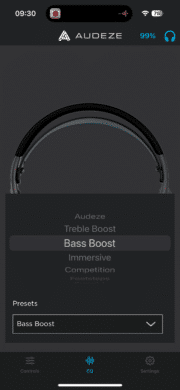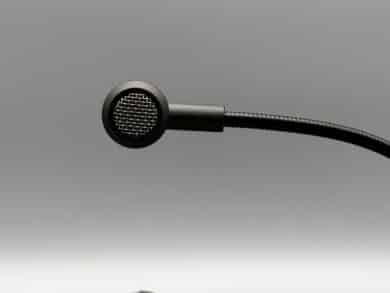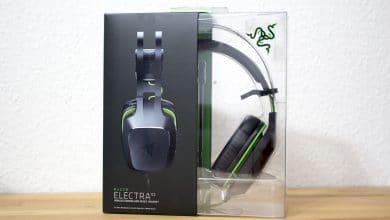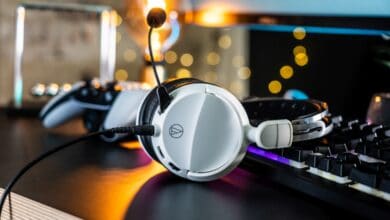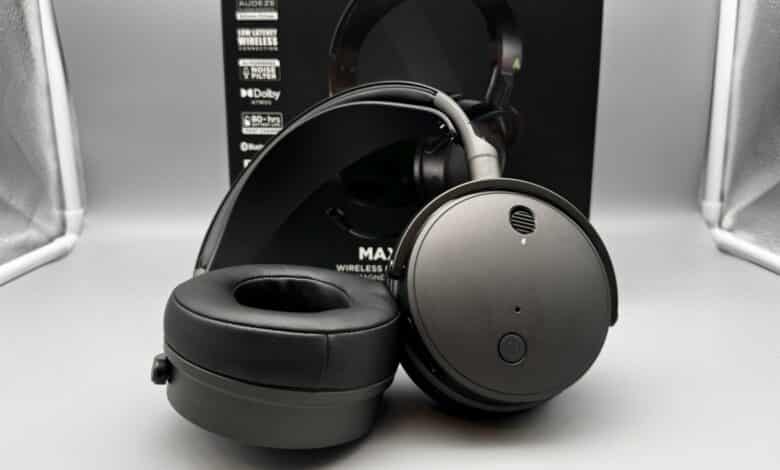
The Audeze Maxwell wireless gaming headset has been hailed as the absolute non-plus-ultra since its release. Having been able to try out pretty much every headset in recent years myself, I can say one thing with certainty: it’s not the best gaming headset on the market, but it’s right up there with the best.
Technical specifications
| The product | Maxwell |
| Design | over-ear |
| driver | 90 mm (planar) |
| Frequency range (headphones) | 10 – 0,000 Hz (wired); |
| Connectivity | Bluetooth 5.3, wireless (2.4 GHz), 3.5 mm jack |
| Microphone type | omni-directional, with noise suppression |
| Range (wireless) | Approx. 15 meters |
| Battery life | 80+ hours |
| Charging time | 2 hours |
| weight | 423 g |
| price | € 349.00 * |
Audeze Maxwell test: Large, heavy and high quality
- Very heavy and bulky
- Simple, pleasing design
- high wearing comfort
The Audeze Maxwell is undoubtedly the tank among wireless gaming headsets. The headphones weigh 423 grams including the detachable microphone boom – that’s a lot even for a wireless headset.
By comparison, our previous reference in the wireless gaming headset segment, the SteelSeries Arctis Nova Pro Wireless (our test), is significantly lighter at 338 grams.
The headset is just as bulky on the head. If you like it delicate and inconspicuous, you’ve undoubtedly come to the wrong place. However, I really like the look of the Maxwell. Simple, yet high-quality. With a lightly anodized grey finish, without eye-catching design accents and other frippery – simply reduced to the essentials.
Audeze provides the device with large imitation leather ear pads that completely enclose the ear and are a comfortable 24 mm thick. At 67 mm x 52 mm, they also provide sufficient space for larger ears and score points with a good passive seal.
The headband only has a thin leatherette padding, but – similar to SteelSeries – is held in place by a ski goggle headband that is height-adjustable in three stages. This is also the only way to adjust the size of the headset to your own head shape.
Despite the high weight and bulky construction, the wearing comfort of the Audeze Maxwell is absolutely impressive. Even after several hours of use, the headphones rested comfortably on my head.
Features and operation
- Bluetooth 5.3, 2.4 GHz and two cable modes
- Multipoint
- Dolby Atmos surround sound
The Audeze Maxwell is a wireless gaming headset that operates either in 2.4 GHz wireless mode or via Bluetooth 5.3 (including LE Audio and LDAC). Bluetooth Multipoint for switching between two audio devices is also included.

.
Unfortunately, simultaneous use via Bluetooth and wireless is not possible. Switching between modes is also unnecessarily cumbersome. If you use the headset wirelessly on a PC or console and have paired it with your smartphone via Bluetooth at the same time, it must first be disconnected from the smartphone in order to display the game sound.
Unfortunately, the Maxwell does not offer a dedicated switch for the operating mode. However, the jack and Bluetooth can be used in parallel.

.
The headset is available in two versions: A PlayStation and an Xbox model. Both are compatible with the PC, but Dolby Atmos is only available in the Xbox version, while the PlayStation version is compatible with Sony’s Tempest 3D audio engine. However, the Maxwell can also be operated on the other console, but then wired.
A USB-C port and a 3.5 mm jack connection are also available for audio transmission. Very commendable.
Operation of the Audeze Maxwell
- Reliable, sophisticated operation
- average PC app
- Smartphone app rather unusable
The Audeze Maxwell is operated in the classic way using buttons and dials, which, with the exception of the microphone mute and power buttons, are located on the underside of the left ear cup.
It starts at the very front with a button that can be used to deactivate the noise suppression of the microphone and adjust it in two stages. This is followed by connections for the microphone, USB-C and jack. Finally, there are two clickable and pleasantly rasterized rotary wheels: the first regulates the balance between game sound and chat, the second increases or decreases the volume of the headset.
A single or double tap on the dials can be used to skip to the previous or next song, select the equalizer preset or adjust the microphone sidetone, for example. It all works flawlessly and precisely.
The Audeze HQ app is also used on the PC and smartphone, but it only has an average range of functions. Only the sidetone and equalizer can be adjusted here, and the automatic switch-off when not in use can be set.
While all this still works well in the PC app, the smartphone counterpart is noticeably bitchier and sometimes refuses to work at all when the USB dongle is connected to the PC or console.
Unfortunately, the smartphone app often hangs or occasionally fails to recognize the connected headset. This can be done better, as the SteelSeries Arctis Nova 5 (our test) recently proved.
Playback and recording quality
Let’s get this out of the way first: The Audeze Maxwell offers outstanding sound quality. Most of the time anyway. The headset owes this primarily to the huge 90 mm magnetic planar drivers, which are twice as large as the usual gaming headset counterparts.
They reproduce a frequency response from 10 Hz to 50,000 Hz and have real studio qualities with their neutral sound. For the Audeze Maxwell test, I took my time and put the headset through its paces in a wide range of disciplines.
Single-player gaming
First up were a few single-player games. These included Banishers: Ghosts of New Eden, Hades II and Dragon’s Dogma 2. Here, the Maxwell delivers an impressive sound image and conjures up acoustic details that many other colleagues swallow up.
Banishers in particular offers an incredibly dense and atmospheric soundscape that is full of small details. The Maxwell reproduces these with a brilliance that few gaming headsets can match.
At the same time, the neutral sound image is pleasantly balanced and scores with amazingly rich and detailed bass, pleasantly spacious and wide mids and good highs.
However, the latter are noticeably less airy and open than the Maxwell’s perhaps worst competitor: the recently released beyerdynamic MMX 300 Pro (our test). There are also some minor inconsistencies in the low bass segment, but the presentation is still better than with other gaming headsets.
The headset can only reach its full potential at high volumes. The mids only come into their own from a level of around 75 percent. Before that, they are somewhat in the background, which makes the overall sound (subjectively) less detailed and lively.
Multiplayer gaming
The situation is different in multiplayer gaming. Especially when it comes to competitive shooters, the Audeze Maxwell unfortunately can’t keep up with the MMX 300 Pro or Arctis Nova Pro in my opinion, as the sound image – even with Dolby Atmos – lacks spatiality and important acoustic cues such as enemy footsteps or similar are noticeably in the background.
Although you can counteract this somewhat with the help of the equalizer, for which there is a special “Footsteps” preset, the Maxwell does not come close to the sound characteristics of the aforementioned headsets. Even with a little fine-tuning in the manual EQ, the sound could not be perfectly tuned as I would have liked for Valorant, The Finals and co.
In addition, there is a slight (but noticeable) inconsistency between the left driver and right driver in terms of sound. This makes it even more difficult to localize sounds in the game.
These are also the reasons why the Audeze Maxwell cannot claim to be the best gaming headset in general in my opinion. Anyone who knows that they play a lot of competitive shooters, in which acoustic cues such as footsteps are crucial to the game, will be much better off with beyerdynamic and the like.
Music
What the Maxwell lacks in the competitive area, the wireless gaming headset makes up for, especially when listening to music. I really like the fairly neutral sound here.
Especially with high-quality mixes, the drivers still tease details out of the songs that even high-quality headphones such as the Sony WH 1000XM5 and other models lack.
I fired up the headset with my mixed headphone test playlist, which contains tracks from a wide variety of genres. I was surprised at the details that still lurk beneath the surface in “Hysteria” by Muse, for example, and the subtle nuances that “Chinese Medicine” by King Nun still hides behind its chorus. In short, the Audeze Maxwell cuts an excellent figure when listening to music.
Microphone quality of the Audeze Maxwell
The Maxwell is equipped with two types of microphone. On the one hand, there are four beamforming microphones in the housing, which enable communication without the attachable microphone boom. However, their quality is only average and appears somewhat lacking in detail and flat.
With the attachable microphone boom, however, things look quite different. Here, the Maxwell delivers an impressively clear and detailed sound that hardly differs between wireless and wired use.
The headset is at the forefront here, reproducing your own voice vividly, in rich detail and, above all, naturally. The only thing I don’t like is how easy the microphone boom is to move. A light touch is enough to unintentionally adjust the position.
Audeze Maxwell microphone test recording (wireless):
Audeze Maxwell microphone test recording (wired):
beyerdynamic MMX 300 Pro microphone test recording:
Over 80 hours of battery life
The large housing of the Audeze Maxwell naturally also has another advantage: it offers space for a particularly large battery. And this has a capacity of 1,800 mAh and, according to the manufacturer, a battery life of over 80 hours.
Even after several hours of gaming, the battery only drained by a few percentage points, so the 80+ hours is by no means an exaggeration. This makes the Maxwell a real endurance runner that easily outperforms most of its competitors.
Audeze Maxwell test: Conclusion
With the Audeze Maxwell, the manufacturer has created a really convincing wireless gaming headset that impresses above all with its neutral sound and excellent workmanship.
However, I can’t fully comprehend the enormous amount of praise, because in terms of sound, the Maxwell is on a par with the current top models from SteelSeries and beyerdynamic in games. However, if you play a lot of competitive shooters, the Audeze model is actually at a disadvantage, as the headset does not reproduce footsteps and other details as clearly and loudly as the aforementioned competitors.
Nevertheless, the overall package is absolutely right here, because with its diverse connectivity options, outstanding battery life and – despite its high weight – successful wearing comfort, the gaming headset scores many plus points on the plus side.
Audeze Maxwell
Workmanship
Wearing comfort
Sound quality
Recording quality
Features
Value For Money
93/100
Extremely high-quality and robust wireless gaming headset with great sound, excellent battery life and many practical features. However, the app connection and sound in competitive games are not entirely convincing.













